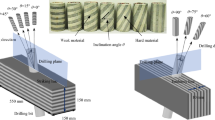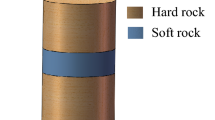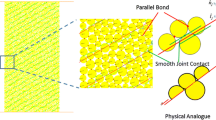Abstract
Uniaxial compression simulation tests were conducted on composite rock containing weak interlayers, investigating the influence of the number of weak interlayers and dip angle (θ = 0°90°) on the physical and mechanical parameters, anisotropy, and failure modes of the rock. The results demonstrate a correlation between the uniaxial compressive strength and elastic modulus with the number of weak interlayers and dip angle. The axial strain of the peak strength generally increases with an augmented number of weak interlayers, exhibiting a pattern of increase, decrease, and subsequent increase with varying dip angles. Microcracks predominantly originate in the interface and loading plate area, extending to the weak interlayer and adjacent regions, forming continuous fractures until the rock undergoes complete failure. The number and dip angle of the interlayer not only impact the physical properties but also govern the failure mode of the rock. The increase in weak interlayers shifts the postpeak curve from brittle to ductile damage, resulting in diverse final failure modes at different dip angles. A total of five distinct final failure modes were identified by examining the macroscopic fracture surface of the rock.








Similar content being viewed by others
References
Jeon S, Kim J, Seo Y et al (2004) Effect of a fault and weak plane on the stability of a tunnel in rock-a scaled model test and numerical analysis. Int J Rock Mech Min Sci. https://doi.org/10.1016/j.ijrmms.2003.12.021
Liu J, Li Q, Wang X et al (2022) Dynamic multifractal characteristics of acoustic emission about composite coal-rock samples with different strength rock. Chaos Solitons Fract 164:112725. https://doi.org/10.1016/j.chaos.2022.112725
Li Y, Liu W, Yang C et al (2014) Experimental investigation of mechanical behavior of bedded rock salt containing inclined interlayer. Int J Rock Mech Min Sci 69:39–49. https://doi.org/10.1016/j.ijrmms.2014.03.006
Tien Y, Tsao P (2000) Preparation and mechanical properties of artificial transversely isotropic rock. Int J Rock Mech Min Sci 37(6):1001–1012. https://doi.org/10.1016/S1365-1609(00)00024-1
Tien Y, Kuo M, Juang C (2006) An experimental investigation of the failure mechanism of simulated transversely isotropic rocks. Int J Rock Mech Min Sci 43:1163–1181. https://doi.org/10.1016/j.ijrmms.2006.03.011
Luo P, Li D, Ma J et al (2023) Experimental investigation on mechanical properties and deformation mechanism of soft-hard interbedded rock-like material based on digital image correlation. J Market Res 24:1922–1938. https://doi.org/10.1016/j.jmrt.2023.03.145
Shen P, Tang H, Zhang B et al (2021) Investigation on the fracture and mechanical behaviors of simulated transversely isotropic rock made of two interbedded materials. Eng Geol 286(2):106058. https://doi.org/10.1016/j.enggeo.2021.106058
Zhang G, Li Y, Yang C et al (2012) Physical simulation of deformation and failure mechanism of soft and hard interberdded salt rocks. Chin J Rock Mech Eng 31(9):1813–1820
Zhao Z, Liu H, Ma Q et al (2023) Micro-macro damage, deterioration and cracking of heterogeneous composite rock masses with non-penetrating cracks under uniaxial compression. Theoret Appl Fract Mech 125:103919. https://doi.org/10.1016/j.tafmec.2023.103919
Cheng J, Yang S, Ying P et al (2018) Experimental study of the deformation and strength behavior of composite rock specimens in unloading confining pressure test. J China Univ Min Technol 47(6):1233–1242. https://doi.org/10.13247/j.cnki.jcumt.000945
Chen J, Gu S, Zhou X (2023) The effects of weak interlayers on the dynamic mechanical properties and failure behaviours of rocks: a combined numerical and experimental analysis. Int J Impact Eng 2023:104680. https://doi.org/10.1016/j.ijimpeng.2023.104680
Yao C, Li Y, Jiang Q et al (2015) Mesoscopic model of failure process of interlayered rock under compression. Chin J Rock Mech Eng 34(8):1542–1551. https://doi.org/10.13722/j.cnki.jrme.2014.0387
Li A, Shao G et al (2018) Uniaxial compression test and numerical simulation for alternatively soft and hard interbedded rock mass. J Hohai Univ (Nat Sci) 46(6):6. https://doi.org/10.3876/j.issn.1000-1980.2018.06.010
Li A, Shao G, Fan H et al (2014) Investigation of mechanical properties of soft and hard interbedded composit rock mass based on meso-level heterogeneity. Chin J Rock Mech Eng 2014(S1):3042–3049. https://doi.org/10.13722/j.cnki.jrme.2014.s1.064
Chen Y, Zhang Y, Li K et al (2017) Distinct element numerical analysis of failure process of interlayered rock subjected to uniaxial compression. J Min Saf Eng 34(4):796–802. https://doi.org/10.13545/j.cnki.jmse.2017.04.027
Liang Z, Tang C, Li H et al (2005) A numerical study on failure process of transversely isotropic rock subjected to uniaxial compression. Rock Soil Mech 26(1):57–62. https://doi.org/10.16285/j.rsm.2005.01.013
He Z, Tang C, Li H et al (2010) Test and numerical simulation for stratified rock mass under uniaxial compression. J Central South Univ (Sci Technol) 41(5):1906–1912
Kang Y, GU J, Wei M et al (2023) Mechanical properties and acoustic emission characteristics of soft-hard interbedded rocks under different loading rates. J Northeastern Univ (Nat Sci) 44(3):399–407. https://doi.org/10.12068/j.issn.1005-3026.2023.03.013
Huang F, Zhu H, Xu Q et al (2013) The effect of weak interlayer on the failure pattern of rock mass around tunnel–Scaled model tests and numerical analysis. Tunn Undergr Space Technol 35:207–218. https://doi.org/10.1016/j.tust.2012.06.014
Ding S, Jing H, Chen K et al (2017) Stress evolution and support mechanism of a bolt anchored in a rock mass with a weak interlayer. Int J Min Sci Technol 27(3):573–580. https://doi.org/10.1016/j.ijmst.2017.03.024
Zhao JS, Feng XT, Jiang Q et al (2018) Microseismicity monitoring and failure mechanism analysis of rock masses with weak interlayer zone in underground intersecting chambers: a case study from the Baihetan Hydropower Station, China. Eng Geol 245:44–60. https://doi.org/10.1016/j.enggeo.2018.08.006
Zhao D, Xia Y, Zhang C et al (2022) Failure modes and excavation stability of large-scale columnar jointed rock masses containing interlayer shear weakness zones. Int J Rock Mech Min Sci 159:105222. https://doi.org/10.1016/j.ijrmms.2022.105222
Ivars D, Pierce M, Darcel C et al (2011) The synthetic rock mass approach for jointed rock mass modelling. Int J Rock Mech Min Sci 48(2):219–244. https://doi.org/10.1016/j.ijrmms.2010.11.014
Wu S, Zhou Y, Gao L et al (2013) Application of epuivalent rock mass technique to rock mass engineering. Chin J Rock Mech Eng 29(7):1435–1441
Zhou Y, Wu S, Wang L et al (2013) Application of equivalent rock mass technique to mesoscopic analysis of fracture mechanism of rock specimen containing two intermittent joint. Rock Soil Mech 34(10):2801–2809. https://doi.org/10.16285/j.rsm.2013.10.00
Jiang M, Fang W, Si M et al (2015) (2015) Calibration of micro-parameters of parallel bonded model for rocks. J ShanDong Univ (Eng Sci) 04:53–59. https://doi.org/10.6040/j.issn.1672-3961.0.2014.183
Potyondy D, Cundall P (2004) A bonded-particle model for rock. Int J Rock Mech Min Sci 41(8):1329–1364. https://doi.org/10.1016/j.ijrmms.2004.09.011
Acknowledgements
The authors acknowledge the financial support from the National Natural Science Foundation of China through the Project No.52934003. The authors also acknowledge the reviewer’s work contributing to this article.
Author information
Authors and Affiliations
Corresponding author
Ethics declarations
Conflict of interest
The authors declared that they have no conflicts of interest in this work.
Additional information
Publisher's Note
Springer Nature remains neutral with regard to jurisdictional claims in published maps and institutional affiliations.
Rights and permissions
Springer Nature or its licensor (e.g. a society or other partner) holds exclusive rights to this article under a publishing agreement with the author(s) or other rightsholder(s); author self-archiving of the accepted manuscript version of this article is solely governed by the terms of such publishing agreement and applicable law.
About this article
Cite this article
Nian, Y., Wu, S. & Han, S. Numerical simulation of mechanical and fracture behavior of composite rock containing weak interlayers. Comp. Part. Mech. (2023). https://doi.org/10.1007/s40571-023-00696-6
Received:
Revised:
Accepted:
Published:
DOI: https://doi.org/10.1007/s40571-023-00696-6




